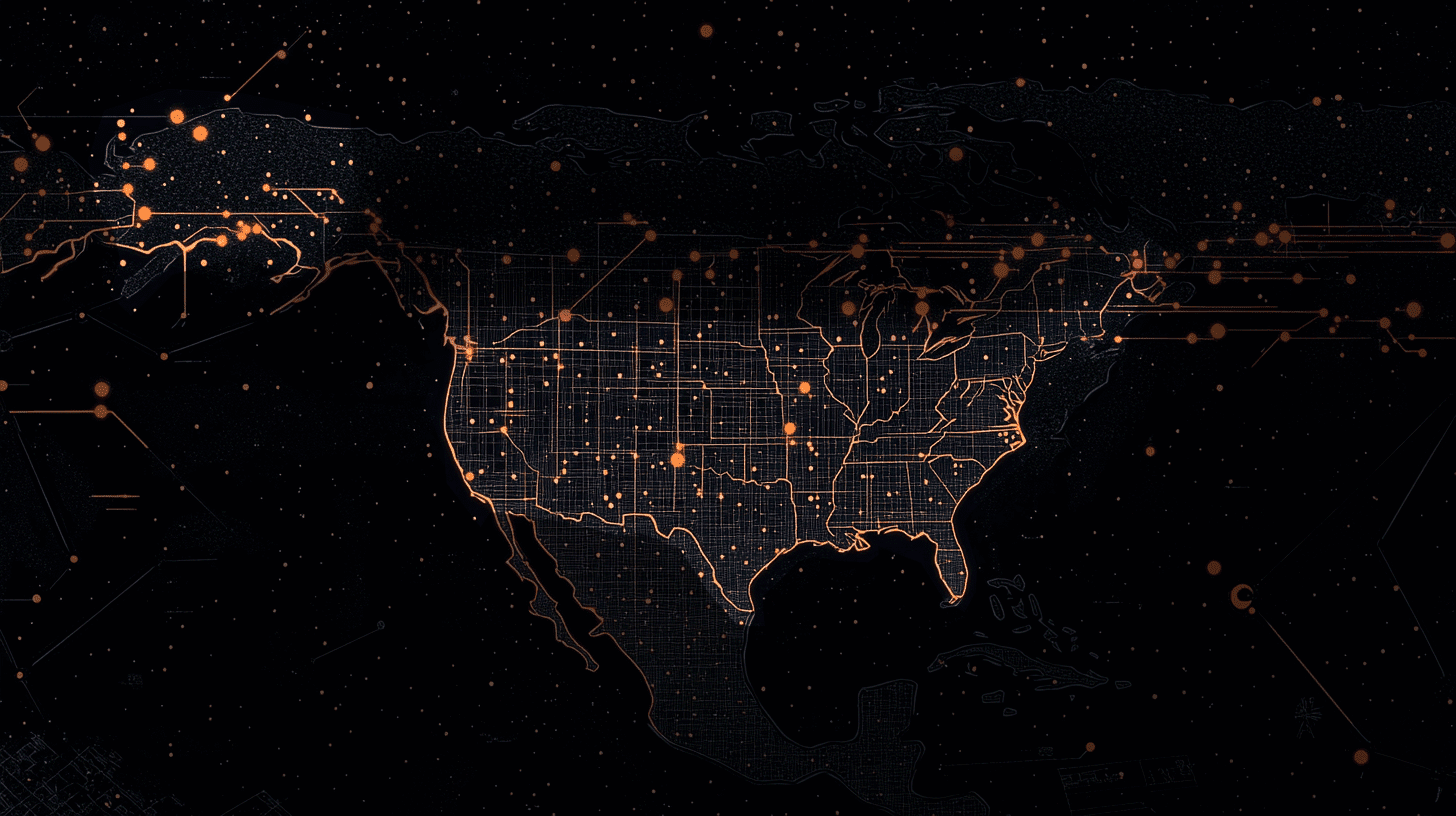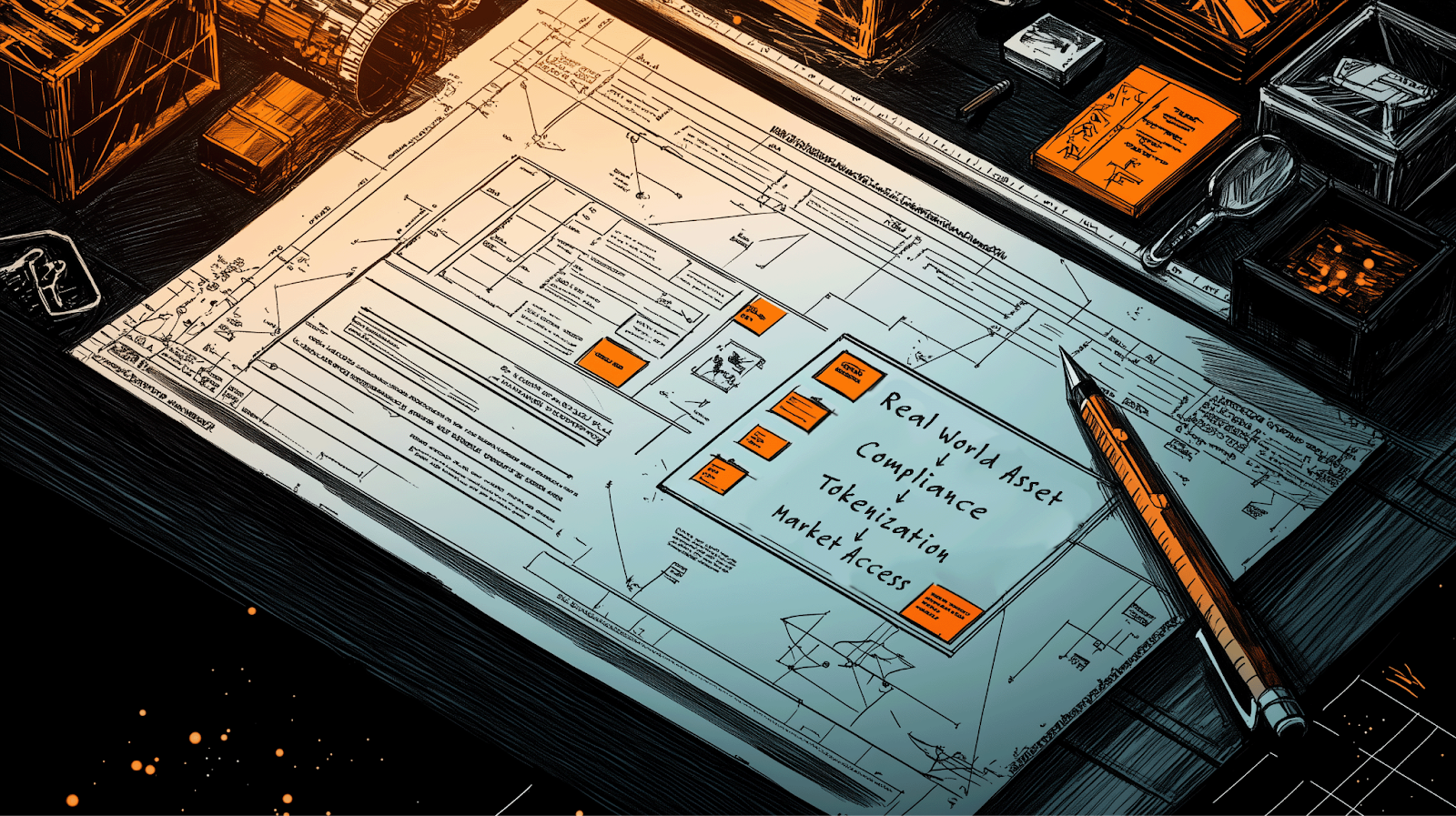America's $37 Trillion Problem Has an Unlikely Solution: The Unseen Infrastructure No One Is Talking About

Jason Dussault
Chief Executive Officer, Co-Founder

This Post is Disseminated on behalf of Intellistake Technologies Corp.
Three months ago, I was looking at the US national debt clock and realized something that kept me up that night. The US crossed $37 trillion faster than anyone expected, and more importantly, the countries that used to help fund that debt are walking away. China's Treasury USD holdings just hit their lowest point since 2008. That's not a coincidence…
that's a signal.
U.S. federal debt jumped from $35.5 trillion in September 2024 to $37.4 trillion by September 20251. But here's what really got my attention: the US is now spending more on interest payments ($882 billion in 2024) than it spends on defense2. Projections suggest this could hit $1 trillion by 20263. When your interest bill exceeds your military budget, something fundamental has shifted.
Foreign central banks at the New York Fed are holding $3.22 trillion in Treasuries; sounds like a lot until you realize that's the weakest level since 20174. The traditional backstop for American debt is quietly eroding, and I think most people haven't fully grasped what that means.
China's Digital Head Start

Beijing saw this coming years ago. They started researching a digital yuan back in 20145, launched pilot programs by 2020, and by 2024 their e-CNY had processed ¥7 trillion in transactions—roughly $986 billion—with over 180 million digital wallets across 26 regions6. They're also building the mBridge project with Hong Kong, the UAE, Thailand, and Saudi Arabia for instant cross-border payments that completely bypass the dollar7.
Their approach is centralized, state-controlled, and designed specifically to work around American financial infrastructure. It's efficient, but it's also closed.
America's taking a completely different path, and honestly, I think it's the smarter play. Instead of creating a government digital currency, they're doing what America did with the internet; building open systems and letting innovation happen. The timeline tells the story: Bitcoin ETFs approved in January 20248, the White House authorized a Strategic Bitcoin Reserve in March 20259, the House passed the Anti-CBDC Act in July blocking any centralized digital dollar10, and the SEC streamlined crypto ETF approvals by September11.
This reminds me of how the US handled the early internet. America didn't own TCP/IP, but they built Google, Amazon, and Microsoft. Sometimes winning means creating infrastructure that everyone else becomes dependent on.
Michael Saylor from Strategy (formally named MicroStrategy) has been pushing this idea hard, even suggesting the U.S. should sell its gold reserves and convert them to Bitcoin BTC. At this year's Bitcoin Unconference, he said something that really resonated: "We're on the verge of the creation of a digital credit market. And still, Wall Street and the world don't realize it."12 Peter Thiel's Founders Fund has been quietly positioning in Ethereum and tokenized treasury strategies13. When people like that start moving, I pay attention.
Where the Smart Money Is Moving

The macro data backs this up. Central banks bought over 1,000 tonnes of gold annually between 2022 and 202414. Gold prices surged above $3,700 per ounce in 202515. Foreign holdings of U.S. Treasuries hit $9.1 trillion in July 2025, but China's cutting back to levels we haven't seen since 200816. In early September, spot Bitcoin ETFs pulled in $887 million in just five trading days17.
Money is clearly moving, but I think most people are missing where the real opportunity lies. This isn't about buying Bitcoin on Coinbase or trading tokens on weekends. The real opportunity is in the infrastructure that makes these open networks actually function at scale.
During the internet boom, some of the companies that built the underlying systems often outperformed many who just used them. Right now, someone needs to build the validator networks that secure blockchains, the custody systems that institutions will actually trust, and the compliance frameworks that can bridge traditional finance into decentralized systems. This is the ‘unsexy’ infrastructure layer that most people ignore...
Building the Infrastructure Everyone Else Will Need

That's exactly what we're focused on at Intellistake Technologies Corp. (CSE: ISTK | OTCQB: ISTKF | FSE: E41).
Our recent Letter of Intent to acquire Singularity Venture Hub isn't just about acquiring a company that has $90 million in managed assets or their incubated project portfolio that reached a valuation of $250 million. It's about positioning ourselves for what I think is coming next.
Everyone's talking about companies adding Bitcoin to their treasury strategies; M. Saylor’s ‘Strategy’, Tesla, others are exploring it. But what happens when they want to go further? What about when real world mining and exploration companies want to tokenize their royalties, or when data centers want to offer fractional ownership of their hardware and infrastructure? What about tokenizing the power contracts that supply these facilities, or creating on-chain representations of mining concessions?
Once the transaction (which remains subject to conditions) closes, SVH will bring us Swiss licensing and secure Fireblocks infrastructure that already handles over $10 trillion in global transactions. More importantly, it will also give us the compliance framework to help companies bridge their real-world assets onto blockchain networks. If this acquisition closes as expected and the regulatory framework permits, we'd have the infrastructure to support companies wanting these much bigger strategies.
I've been watching how quickly the conversation has shifted from "should we hold digital assets?" to "how do we actually build our operations around these assets?" Companies are realizing they need the infrastructure to custody these assets properly (without any single points of failure or compromise), validate the networks they're built on, and potentially tokenize their own real-world holdings. That's infrastructure work, and it's exactly what technologies we've been building toward.
The thing is, most companies adopting digital asset strategies or exploring on-chain operations don't want to build this infrastructure themselves. They want to focus on their core business while someone else handles the validator operations, custody solutions, and compliance frameworks. That's the layer we're building; the ‘unsexy’ but essential infrastructure that enables everyone else's strategies.
I can't predict exactly how this monetary shift plays out, but the trends seem pretty clear. Traditional buyers of U.S. debt are pulling back, alternative assets are gaining institutional adoption, and
digital infrastructure is becoming critical for both AI and finance. We're not here to speculate on outcomes; we're helping to build the systems that could make decentralized finance and real-world asset tokenization much more viable and accessible for institutions.
Historical data suggests that the companies building foundational infrastructure often end up in stronger positions than those just participating in the markets those systems create. Maybe I'm wrong, but the $37 trillion question feels like it's already being answered by where the smart money is moving...
Sources
1) https://fiscaldata.treasury.gov/americas-finance-guide/national-debt/
2) https://www.crfb.org/blogs/interest-costs-just-surpassed-defense-and-medicare
3) https://www.crfb.org/blogs/interest-debt-grow-past-1-trillion-next-year
4) https://www.reuters.com/markets/europe/foreign-central-banks-are-shrinking-us-asset-exposure-2025-06-17
5) https://www.fpri.org/article/2023/06/china-is-doubling-down-on-its-digital-currency
6) https://undcif.org/e-cny-advancing-functional-capabilities-in-sovereign-digital-currency
7) https://www.bis.org/press/p240605.htm
8) https://www.sec.gov/newsroom/speeches-statements/gensler-statement-spot-bitcoin-011023
9) https://www.whitehouse.gov/presidential-actions/2025/03/establishment-of-the-strategic-bitcoin-reserve-and-united-states-digital-asset-stockpile/
10) https://emmer.house.gov/media-center/press-releases/majority-whip-tom-emmer-s-flagship-legislation-the-anti-cbdc-surveillance-state-act-passes-house-of-representatives
11) https://finance.yahoo.com/news/crypto-etfs-set-flood-us-100554382.html
12) https://www.thestreet.com/crypto/markets/michael-saylor-steps-into-trumps-favorite-bar-but-skips-paying-with-bitcoin
13) https://www.wsj.com/finance/currencies/peter-thiel-ether-investors-39b37a98?gaa_at=eafs&gaa_n=ASWzDAjkNQpfBOmmRV569WUvicTIqw6hr453bnKQmDFj0U_4DW12wxPq3Yz3&gaa_sig=r--Wz4NdJSP5lPkhf_hUyxxhmmGTRhREscDyXIprO38LjK6MyZgGceGKl8o1Qf11KtE5Gxgjvzg8iztY58_Utg%3D%3D&gaa_ts=68d5d255&utm_
14) https://www.reuters.com/business/finance/golds-record-breaking-rally-whos-keeping-it-going-2025-09-22/
15) https://markets.businessinsider.com/news/commodities/china-gold-demand-falls-stock-market-rally-wgc-retail-investors-2025-9?utm_
16) https://www.reuters.com/world/china/foreign-holdings-us-treasuries-surge-all-time-high-july-chinas-sink-2025-09-18/
17) http://tradingnews.com/news/bitcoin-etf-oinflows-887m-usd-as-blacksrock-ibit-nears-85b-usd-aum
Disclaimer
Completion of the transaction with Venture Hub remains subject to completion of satisfactory due diligence, the negotiation and execution of a definitive agreement (“Definitive Agreement”) that will include representations, warranties, covenants, indemnities, termination rights, and other provisions customary for a transaction of this nature, no objection from the Canadian Securities Exchange, and shareholder approval of Venture Hub, if required. The parties intend to finalize the Definitive Agreement within approximately 45 days, with a closing targeted within 60 days thereafter, subject to satisfaction of closing conditions in the Definitive Agreement.
There has been significant volatility in digital assets and their value can decline rapidly, which in turn would lead to a decline in the stock price of companies holding digital assets. Intellistake is a start-up that does not have the same access to capital as other larger more established companies.
Any tokenization will be subject to it being completed in compliance with applicable law, regulatory requirements and terms of any underlying agreements associated with the relevant assets. The actual structure of such tokenization, the assets that would be subject to tokenization, and the associated timeline, have not yet been determined. Intellistake will provide further updates as material developments related to this tokenization strategy occur.
Intellistake has just commenced operating its business and is at an early stage of development. Intellistake is entering this space by acquiring and operating blockchain validator hardware that supports AI networks and investing in AI-related digital tokens to primarily operate validator hardware.
Intellistake is developing custom AI software systems called "AI Agents" for businesses. It recently announced the development of IntelliScope, a newly designed enterprise artificial-intelligence (AI) suite that applies decentralized AI technologies to deliver transparent and verifiable corporate intelligence. IntelliScope, which is in testing, is being publicly introduced as Intellistake's enterprise AI suite, reflecting the Company's focus on advancing practical applications of decentralized AI technologies.
The IntelliScope suite is being developed as a collection of modular AI agents, each intended to address specific enterprise challenges. Development has advanced through internal closed testing, where functionality is being refined and validated. Built to leverage decentralized AI technologies developed within the ASI Alliance FET token ecosystem, IntelliScope is now preparing to move into closed beta testing with an enterprise client, a phase focused on gathering feedback to shape premium features and expand real-world use cases.
The Company intends to deliver these solutions either as one-time projects or ongoing subscription services. Revenue comes from implementation fees and monthly subscription payments. The Company does not presently have any customers. Intellistake is just commencing operations. It is targeting significant growth but its business is subject to several risks related to general business, economic and social uncertainties; the sufficiency of cash to meet liquidity needs; legislative, political and competitive developments; the inherent risks involved in the digital currency and general securities markets; the volatility of digital currency prices and the additional risks identified in the "Risk Factors" section of the Company’s filings with applicable securities regulators. Intellistake has not yet developed or commercialized its AI solutions.
Intellistake is presently evaluating the regulatory framework for tokenization. Any tokenization will be subject to it being completed in compliance with applicable law, regulatory requirements and terms of any underlying agreements associated with the assets. The actual structure of such tokenization, the assets that would be subject to tokenization, and the associated timeline, have not yet been determined. Intellistake will provide further updates as material developments related to this tokenization strategy occur.
This report contains "forward-looking information" concerning anticipated developments and events related to the Company that may occur in the future. Forward looking information contained in this report includes, but is not limited to, all statements in respect of the Company's growth and development, the operations and business segments of the Company, expectations regarding the market for digital currencies and decentralized AI, support for decentralized AI and blockchain networks, expected allocation amounts for and selection of digital currencies, leveraging blockchain technology to support long-term stakeholder value, a broader strategy to grow the Company’s position in AI and tech digital assets, development of AI Agents and the commercialization thereof, operation of validator infrastructure, opportunities for token rewards, revenue generation potential and commencement of staking and validator operations.
In certain cases, forward-looking information can be identified by the use of words such as "expects", "intends", "anticipates" or variations of such words and phrases or state that certain actions, events or results "may", "would", or "might" suggesting future outcomes, or other expectations, assumptions, intentions or statements about future events or performance. Forward-looking information contained in this report is based on certain assumptions regarding, among other things, the Company will continue to have access to financing until it achieves profitability; the technology and blockchain industries in which the Company intends to focus its business in will grow at the rate and in the manner expected; the ability to attract and retain qualified personnel; the success of market initiatives and the ability to grow brand awareness; the ability to distribute Company's services; the Company creates strategies to mitigate risks associated with cryptocurrency price fluctuations; the Company remains compliant with all applicable laws and securities regulations; the Company engages and collaborates with local experts, as necessary, to address jurisdiction-specific matters and ensures compliance with foreign regulations to avoid penalties; the Company addresses any potential cybersecurity threats promptly and effectively; the AI Agent technology can be developed and deployed with real world applications; and the ability to successfully deploy the new business strategy as a result of the change of business. While the Company considers these assumptions to be reasonable, they may be incorrect.
Forward looking information involves known and unknown risks, uncertainties and other factors which may cause the actual results to be materially different from any future results expressed by the forward-looking information. Such factors include risks related to general business, economic and social uncertainties; failure to raise the capital necessary to fund its operations; inability to create strategies to mitigate the risks associated with cryptocurrency price fluctuations; risks relating to the ability to develop the AI Agent technology and relating to the deployment of validator operations; the ability to acquire digital tokens at reasonable acquisition prices; the costs of regulation in the digital asset industries increase to the extent that the Company is no longer generating sufficient returns for shareholders; failure to promptly and effectively address cybersecurity threats; insufficient resources to maintain its operations on a competitive basis; and the actual costs, timing and future plans differs expectations; legislative, environmental and other judicial, regulatory, political and competitive developments; the inherent risks involved in the cryptocurrency and general securities markets; the Company may not be able to profitably liquidate its current digital currency inventory, or at all; a decline in digital currency prices may have a significant negative impact on the Company's operations; the Company's success may depend on the continued involvement of key personnel, including advisors, whose involvement cannot be guaranteed; institutional adoption of decentralized AI infrastructure remains uncertain and may not occur at the pace or scale anticipated; evolving regulatory frameworks, including those related to AI (such as Canada's proposed Artificial Intelligence and Data Act), may impose additional compliance burdens or restrict certain business activities; valuation figures are based on publicly available market data and internal assessments at the time of the referenced transactions and may not reflect current or future valuations; the volatility of digital currency prices; the inherent uncertainty of cost estimates and the potential for unexpected costs and expenses, currency fluctuations; regulatory restrictions, liability, competition, loss of key employees and other related risks and uncertainties; delay or failure to receive regulatory approvals; failure to attract qualified personnel, labour disputes; and the additional risks identified in the "Risk Factors" section of the Company's filings with applicable Canadian securities regulators.
Although the Company has attempted to identify factors that could cause actual results to differ materially from those described in forward-looking information, there may be other factors that cause results not to be as anticipated. Readers should not place undue reliance on forward-looking information. The forward-looking information is made as of the date of this report. Except as required by applicable securities laws, the Company does not undertake any obligation to publicly update forward-looking information.




